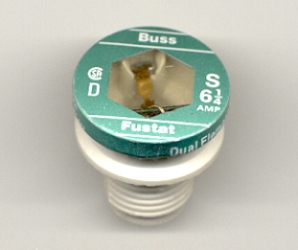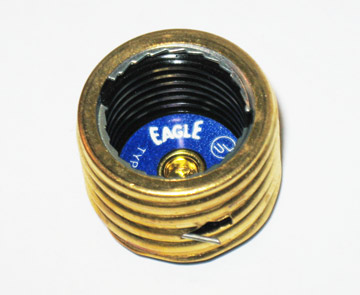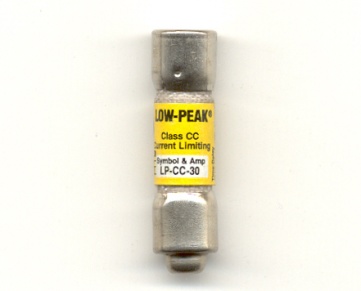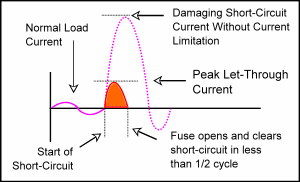Category Archives: Fuses
Residential Overcurrent Devices
CIRCUIT BREAKERS
Circuit breakers are simply switches that have an internal mechanism that senses an overcurrent in the circuit. This could be caused by overloading the circuit with too many appliances connected and operating at the same time. It could be caused by one piece of equipment or appliance that uses a higher current beyond what the circuit was designed to handle. It could also be caused by a short-circuit. The circuit breaker is designed to trip (open) under these conditions. Circuit breakers are designed to protect persons and property from a possible fire. If the circuit breaker itself is defective and does not open or trip when there is an overcurrent, it could cause a fire. Standards have been set up for satisfactory circuit breaker manufacturing.
When checking circuit breakers you need to check visually and manually the exact position of the switch handles. A breaker is ON when the switch handle is fully in the ON position. A breaker may sometimes look ON but it is OFF. A breaker that looks ON and is somewhat in the midway position is OFF and it needs to be reset. Some breakers after they trip, may need to be reset by switching it in the OFF position first, then switching it to ON. You may touch the handles of the circuit breaker switches and you will not be shocked. The handles of a circuit breaker are insulated; thus carry no electrical current.
PLUG FUSES
Older homes used fuses for overcurrent protection. Today, many older homes are upgraded to circuit breakers. In homes with fuses, screw type plug fuses were used. They were made with glass or the top being transparent. This makes it easy to see if the circuit opened by a burnt and melted fuse link. Fuses should always be replaced with the proper sized current protection; replace a 15 amp fuse with a 15 amp fuse; a 20 amp with a 20 amp; and so on. The problem with ordinary plug fuses is that you can increase the amp size on a circuit that may not be designed for the increased amp load. This could pose a fire hazard. One solution to this problem is to use Type S fuses. Type S fuses are rejection or tampering resistant; that is, they have a rejection design which offers resistance with tampering with the established branch circuit design by rejecting certain higher amp rated fuses from being inserted in the holder. You insert a properly rated adapter into the fuse baseholder. The appropriate size fuse screws into the adapter. These adapters limit the ampere rated sizes of fuses and will not allow an oversized fuse to be used. Caution: once the adapter is installed it cannot be removed.

Type S Fuse

Type S Fuse Adapter
If you want to simply disconnect a circuit, remove the fuse from the baseholder by unscrewing it in a counterclockwise direction.
If it is not noticeable through the transparent material that a fuse link has blown or melted open, you may check the fuse by using a voltage tester. Check that the fuse is firmly inserted by twisting it in a clockwise direction. Next, hold one test lead on the neutral bus bar or adequate ground and with the other test lead touch the screwshell of the fuse or if visible, the corresponding circuit wire terminal (usually, horizontally left or right of the fuse).
CARTRIDGE FUSES
In residences with pool motors, air conditioning or other equipment, cartridge fuses may be used in disconnects or fuse boxes to protect motors, compressors and associated equipment from overcurrent conditions.

Another Type of Cartridge Fuse
Fuse Signifying Characters
A question was asked: “The letters, like a FRN-R or FLM or FNM before the Ampere rating (amp), are they referred to specified conditions or is only manufacturers codes?”
Answer: Each manufacturer has their own blend of alphanumeric characters to signify a particular fuse. I am not sure if each character of a particular part number of a fuse serves as a code to explain particulars of that fuse. However, some characters do represent something special or different.
For example: Bussmann has a named fuse FRN. The amperage rating will follow these characters. Like this; FRN-1. One (1) is the amperage rating. I do not know if and what FRN stands for. These fuses are called Fusetron. Is it short for that? If so, then what would the competitor’s equivalent part number represent. Mersen (Gould/Ferraz Shawmut) has an equivalent part series TR. These are called Tri-onic. Again, the amperage rating follows the alpha characters; like TR2.
Now look at this. Bussmann has a fuse named FRN-R. The R after the hyphen is a symbol to represent that the particular fuse is a “rejection” type fuse. Their design is slightly different and have higher interrupt ratings than the FRN type fuses. You cannot physically use an FRN fuse in an FRN-R type fuse block. These fuse blocks are designed to accept only FRN-R type fuses. However, you can use an FRN-R type fuse in an FRN type fuse block. Mersen (Gould-Ferraz Shawmut) uses the symbol TR(amp)R; like this TR2R. The R after the amperage rating signifies “rejection” type fuse. Littelfuse names their equivalent fuse FLNR. Edison has ECNR. With these, I do not know the significance of the first three characters, but the R probably represents “rejection” type.
It appears that the manufacturers try to assign characters of a particular fuse that will distinguish themselves from their competitors, but at the same time have some kind of reference to the type fuse. But what does KTK represent? This is a Bussmann fuse called Limitron. How does two Ks fit into this? It is also fast-acting so a T, which on some fuses might represent time-delay, could not be applied here. Was this an arbitrary decision to name these fuses as such? The manufacturer should know. Littelfuse’s equivalent part symbol is KLK. Maybe the L represents Littelfuse.
So it appears that the alpha characters can represent specified conditions, such as “rejection” type and/or also signify a code for manufacturers’ parts. Whether these characters always have a logical signification, I am not convinced.
Electrical Safety
Electricity can be very dangerous when handled improperly. Not only can a person die from an electrical shock, but also he can receive serious burns. Loss of property can be attributed to fire because of improper wiring or failure of electrical devices and equipment. Some simple electrical devices and equipment are: circuit breakers, fuses, switches, receptacles, lamp fixtures, small and large appliances, heating, wiring, and associated equipment.
Working with electricity can be safe. The key is to never work on an energized circuit. This, of course, is easier said than done for the fact that electricity cannot be seen, heard, smelled, or tasted. Sometimes, when only the conductor of current is touched, do we know electricity is present. This does not have to be this way.
The following electrical safety tips are written so that the person working on electrical equipment will become more aware of what they are doing so they may do it safely.
What Is Ampere Rating?
Ampere rating is an electrical current value given to every fuse. This value is the allowable current which can flow continuously through the fuse under specified conditions. This value can also be referred to as current-carrying capacity or ampacity. Refer to the NEC (National Electrical Code) requirements when selecting a particular fuse for a circuit.
The following is some examples of part numbers and where the current rating (amp) is listed.
FRN-R-(amp); FRS-R-(amp); TR(amp)R; TRS(amp)R; FLNR-(amp); FLSR-(amp); LPN-RK-(amp) LLNRK-(amp); KTK-R-(amp); FNQ-R-(amp); ATQR(amp); ATMR(amp); LP-CC-(amp) A2D(amp)R; A6D(amp)R; LPJ-(amp)SP; AJT(amp); JKS-(amp); FNM-(amp); FLM-(amp); MDL (amp); AGC (amp); 313(amp); 233(amp); FWH-(amp); A50P(amp); A25X(amp).
What Is Interrupt Rating?
“Interrupt rating” is not the same as “ampere rating,” even though both these are dealing with current values.
When reading technical data about a particular fuse you will see symbols or rather abbreviations such as I.R. or IR which refer to “interrupt rating.” Other abbreviations could be A I.R., A IR, or kA I.R. which is “amperes interrupt rating” or “kilo amperes interrupt rating” respectively.
Given a particular rated voltage, this current rating refers to the maximum amount of instantaneous current that can be interrupted safely without explosion or damage to the fuse link carrier, such as the cartridge or tube. This interruption of current flow can occur in fault or short circuit conditions. This current rating has been approved through standardized tests.
Interrupt rating is also referred to as “breaking capacity.”
What Is A Current Limiting Fuse?
When a short circuit occurs, a current limiting fuse, within its current limiting range, opens within ½ cycle. This prevents the damaging overcurrent to reach its maximum instantaneous short-circuit value in the circuit if that fuse were replaced with a solid conductor of comparable oppositional characteristics to current flow. The instantaneous peak let-though current is the actual maximum let-through current value in the circuit before the fuse opens and clears the circuit under short circuit conditions.

Example Current Limitation Sine Wave
What Is A Buss Fuse?
Buss fuse is an electrical device used to interrupt an overcurrent in an electrical circuit. It acts similar to a device called a circuit breaker. However, a fuse has a link that melts when call upon to protect the electrical circuit. This blown fuse or fuses have to be replaced in order for the electrical circuit to continue carrying an energized load. Buss fuses are manufactured by Cooper/Bussmann.
Tell Me About Surplus Fuses
Here is information you need to know about overstock, oversupply, or surplus fuses that are new, nos, and used. This information could save you a significant amount on your fuse purchases.
How fuses are described by the distributor is important for the purchaser in making informed decisions. It is especially important for the surplus fuse supplier that their descriptions remain consistent. The following is the standard for Alan’s Sales.
The word surplus sometimes carries the idea of products being cheap, unreliable, or inexpensively manufactured. But this is just not true if the surplus fuses are named brand. If you purchase a named brand fuse you are getting the same product whether it is surplus or otherwise. With surplus new or new old stock (NOS) fuses, they are simply new and not used. That is, they have not been energized to carry an electrical load.
With a used fuse or those that are shop worn, these blemishes or conditions have no effect on the reliability and performance of the fuse. The interesting fact about fuses is their reliability relative to time.
There are no moving parts, so with a NEW or NOS fuse there is no wear or tear to the product, except for handling, such as in storing and for a USED fuse, handling, installing and removing the fuse – that’s it!
According to Ferraz-Shawmut (Mersen) a leading fuse manufacturer, “The speed of response of a fuse will not change or slow down as the fuse ages. “In other words, the fuse’s ability to provide protection is not adversely affected by the passage of time.” (The Advisor-Application Information, 10 Reasons For Using Current Limiting Fuses)
On occasion, some NEW or NOS fuses may look used, shop worn, or even dirty. The appearance of the fuse does not affect its performance. From a practical sense, it does not really make a difference what the fuse looks like when you install it and put it to work? However, with Alans Sales not all surplus fuses are bad looking. In fact, Alan’s Sales has some pretty good looking USED fuses at some better looking prices. However, the appearance is not guaranteed. Remember, it is the technical and performance aspects of the fuse which serve the purpose in overcurrent circuit protection.
Whether you are purchasing NEW, NOS, or USED fuses, only purchase fuses from dealers who will stand behind their product with a fair refund/exchange policy. Also check out Alan’s Sales high standards for fuse quality control.
Fuses verses Breakers
What about fuses verses breakers? Each of these serve a purpose in providing overcurrent protection in electrical circuits. They both have pros and cons.
Circuit breakers are reusable whenever an electrical circuit experiences an overcurrent in the circuit, which then trips the breaker. The breaker is simply reset with its switch handle. This, at first appearance, can effectively reduce the cost of overcurrent protection especially if you experience high incidents of overcurrents. However, there are still some drawbacks with breakers when comparing them to fuses.
For one, circuit breakers have mechanical parts, which creates an inherent increase in required maintenance for the breakers.
Breakers need to be exercised periodically by switching them. This essentially interrupts active loads. Fuses do not have any moving parts. Therefore, eliminating this kind of maintenance. The cost for maintenance for circuit breakers needs to be factored in when considering the use of fuses verses circuit breakers. Safety may be compromised if breakers are not maintained properly or replaced when the integrity of the breaker has been degraded. Also the associated circuit breaker equipment needs to be maintained, such as the breaker and wire termination points, and ensuring proper mounting.
Fuse associated equipment also needs to be maintained with its terminations, clips, and disconnects; but again, there are no moving parts.
Fuse links are not reusable. Once they experience an overcurrent such as short-circuit or overload beyond its rated limits, it opens (blows) by the fuse link melting. You have to replace the fuse with a new fuse or fuse link. Ironically, here is where using fuses shine. Where circuit breakers can degrade by their movable parts, this can lead to a breaker’s calibrated settings being affected, this does not happen to a fuse.
This is important for various types of circuitry and loads to be protected. If the calibration of the circuit breaker is adversely affected and does not open when called upon based on its current rating, this could possibly damage the conductors or the loads being protected. This also could pose a fire hazard. Using fuses eliminates this potential problem.
Other circuit breaker failure considerations are a burned out trip coil or the trip mechanism becoming immovable because of corroding buildup, dirt, and/or dried out lubricant. Certain breakers with electronic components can also fail when the electronic component fails. Again, these problems can result in a fire hazard to life and property.
Whenever a fuse is called upon to perform its action of protection by the fuse link opening, a new fuse is installed providing optimum calibration settings. Because of this, using fuses provides reliability and confidence of performance beyond that of circuit breakers.
